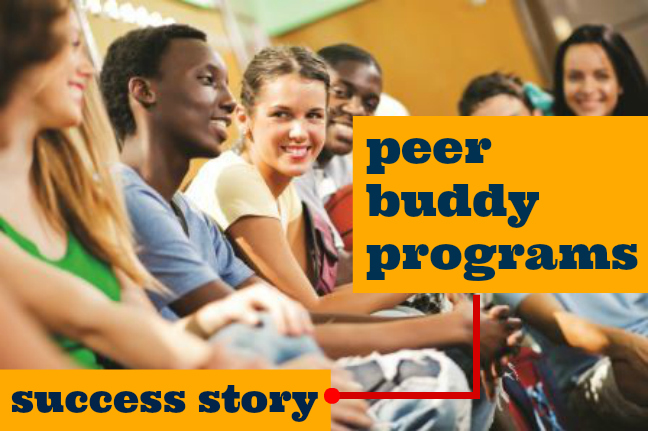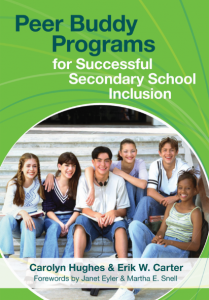A Win-Win: McGavock High’s Peer Buddy Program
April 19, 2016
 A few weeks ago I interviewed Carolyn Hughes, co-author of Peer Buddy Programs for Successful Secondary School Inclusion, about the benefits of peer buddy programs and how they support inclusion in schools. (If you missed the Q&A, you can catch up here.) Today I’m bringing some of Carolyn’s key points to life with a success story excerpted and adapted from her excellent book. Focusing on the Nashville’s McGavock High School, this memorable story shines a spotlight on how a well-planned peer buddy program improves the lives of students with and without disabilities.
A few weeks ago I interviewed Carolyn Hughes, co-author of Peer Buddy Programs for Successful Secondary School Inclusion, about the benefits of peer buddy programs and how they support inclusion in schools. (If you missed the Q&A, you can catch up here.) Today I’m bringing some of Carolyn’s key points to life with a success story excerpted and adapted from her excellent book. Focusing on the Nashville’s McGavock High School, this memorable story shines a spotlight on how a well-planned peer buddy program improves the lives of students with and without disabilities.
One of the largest high schools in Tennessee, McGavock enrolled more than 2,700 students when they started their peer buddy program, more than 300 of whom were receiving special education services. Students with disabilities–especially students with more severe disabilities–spent most of their school day in self-contained or resource classrooms, though they ate lunch in the cafeteria and attended some general education classes. The general and special education teachers felt the McGavock school community could and should do a better job supporting full participation and membership of students with disabilities. But with limited supports available to help teachers adapt curricula and make individualized accommodations, this was a challenging prospect. That’s where the McGavock High peer buddy program came in–and here’s how it helped.
***
TYRELL
Tyrell never had much of an opportunity to get to know students with disabilities at McGavock High School. Sure, he often passed these students in the hallway on the way to his classes or saw them eating together at a table in the lunchroom. But none of them were on the football team with him, enrolled in any of his classes, or participating in any of the extracurricular clubs he enjoyed.
Tyrell was a little curious about what life was really like for students with disabilities at his school. After all, his aunt had taken special education classes, and so had his cousin. But with all of the demands of high school life, he just never got around to finding out.
ALLAN
Allan had always dreamed of becoming a bodybuilder. On almost a weekly basis, he’d ask the coach about enrolling in a weightlifting class–but Coach Fischer always replied with a hesitant “maybe next semester, Allan.” Coach Fischer didn’t think he knew enough about teaching students with disabilities, and with 25 other students in his class, he didn’t feel he had enough time for the individualized support he thought Allan would need. Of course, Allan could always come to class if a paraprofessional would join him, but Allan said that would be too embarrassing. Besides, who would help Allan in the boys’ locker room if he needed it? Allan would just have to wait until next semester.
MS. GLADSTONE’S IDEA
Ms. Gladstone was very aware of the challenges to inclusion in general education encountered by Tyrell and other students with disabilities at McGavock High. Like the other special education teachers in her school, she desperately wanted to find a way to increase the social and academic participation of her students. But how?
Ms. Gladstone brainstormed with a colleague from a local university about the possibility of having peers help support her students. After all, students were literally everywhere at McGavock–and when given the chance, they were often eager to help support their classmates with disabilities. Since an important goal for many of Ms. Gladstone’s students was to increase their social interaction in general education settings, who better to involve in that effort than other students?
A PEER BUDDY PROGRAM IS BORN
The McGavock High School staff–including teachers, administrators, and guidance counselors–worked together to develop a program that would encourage students with and without disabilities to interact regularly with each other. Out of that collaboration, a peer buddy program was created. Here’s how it worked:
- Students without disabilities (peer buddies) received course credit for spending at least one class period each day interacting with and supporting their classmates with disabilities.
- Peer buddies enrolled in the program spent at least one class period each day interacting with and supporting their classmates with disabilities across a variety of settings inside and outside of school.
- Teachers shared information with peer buddies about disability awareness, instructional and motivational techniques, and including students in daily school activities.
- Administrators and guidance counselors played a critical role in getting out the initial word about the program to the student body through a variety of avenues such as closed circuit television and school assemblies.
- School staff developed a process for enrolling students in the program. Students interested in becoming peer buddies met with guidance counselors and special education teachers in an initial screening process. Once enrolled, peer buddies then helped to recruit additional students into the program.
- As peer buddies, students served as positive role models while supporting their peers with disabilities in academic and career education classes. Joint extracurricular activities included student council, cheerleading, school chorus, basketball games, lunch, shopping, and visiting each other’s homes.
A WIN-WIN FOR EVERYONE
Tyrell became Allan’s peer buddy and provided the one-to-one support Allan needed to participate fully in the weightlifting class. It truly was a win”“win situation for everyone–Allan made a new friend and learned new skills that were important to him, Coach Fischer received the additional support he needed in the form of a peer buddy, Ms. Gladstone was able to expand one of her students’ inclusion in general education, and Tyrell learned more about himself and others as a result of his experiences. Some peer buddies in the program, like Tyrell, supported their peers with disabilities in nonacademic classes such as gym, chorus, and art. Others provided support in academic and career education classes or at community-based instruction sites.
Since the peer buddy program began, it’s no longer uncommon to see students with disabilities eating with peers in the lunchroom, hanging out between classes, participating in school clubs, and attending sports events and school dances. Best of all, peer buddies introduce their own friends to their partners with disabilities, enlarging each student’s circle of friends.
The peer buddy program may have started with just one teacher in one classroom in one high school, but the idea spread quickly. Before long, all 11 comprehensive high schools in the school district offered the peer buddy program to students. The program looked a little different in each school, as teachers adjusted activities based on the unique circumstances of their school community. But the overall goals remained the same–to promote inclusion, access to general education, and service-learning opportunities for students.
***
Interested in creating a peer buddy program? Check out Peer Buddy Programs for Successful Secondary School Inclusion–it’s full of step-by-step information on initiating, planning, monitoring, and maintaining a program like McGavock’s in your school.
Already have a peer buddy program in place? Submit your success story to us–we’d love to hear about your challenges and triumphs.




Write a Comment
Your email address will not be published. Required fields are marked *
Post a Comment